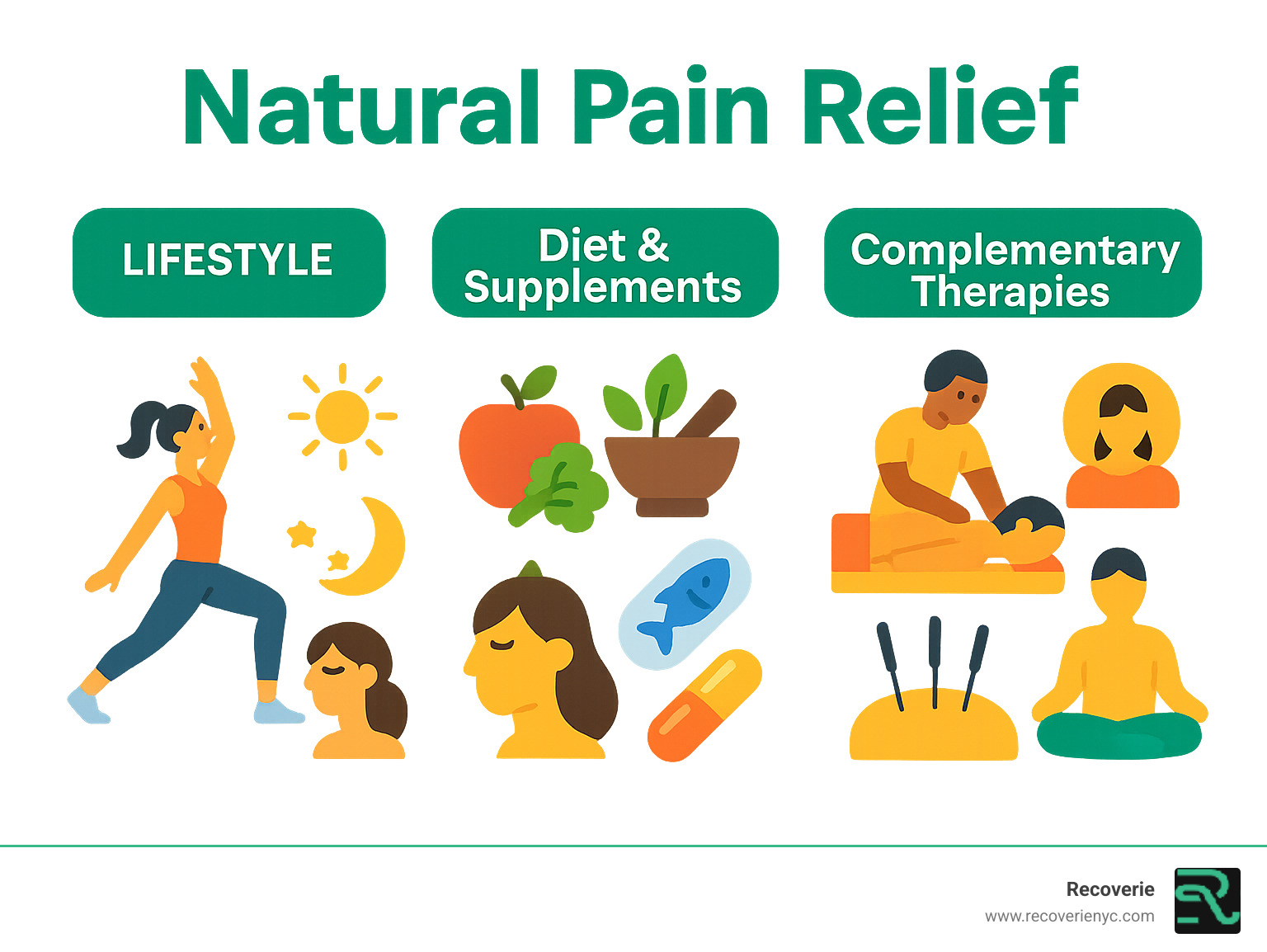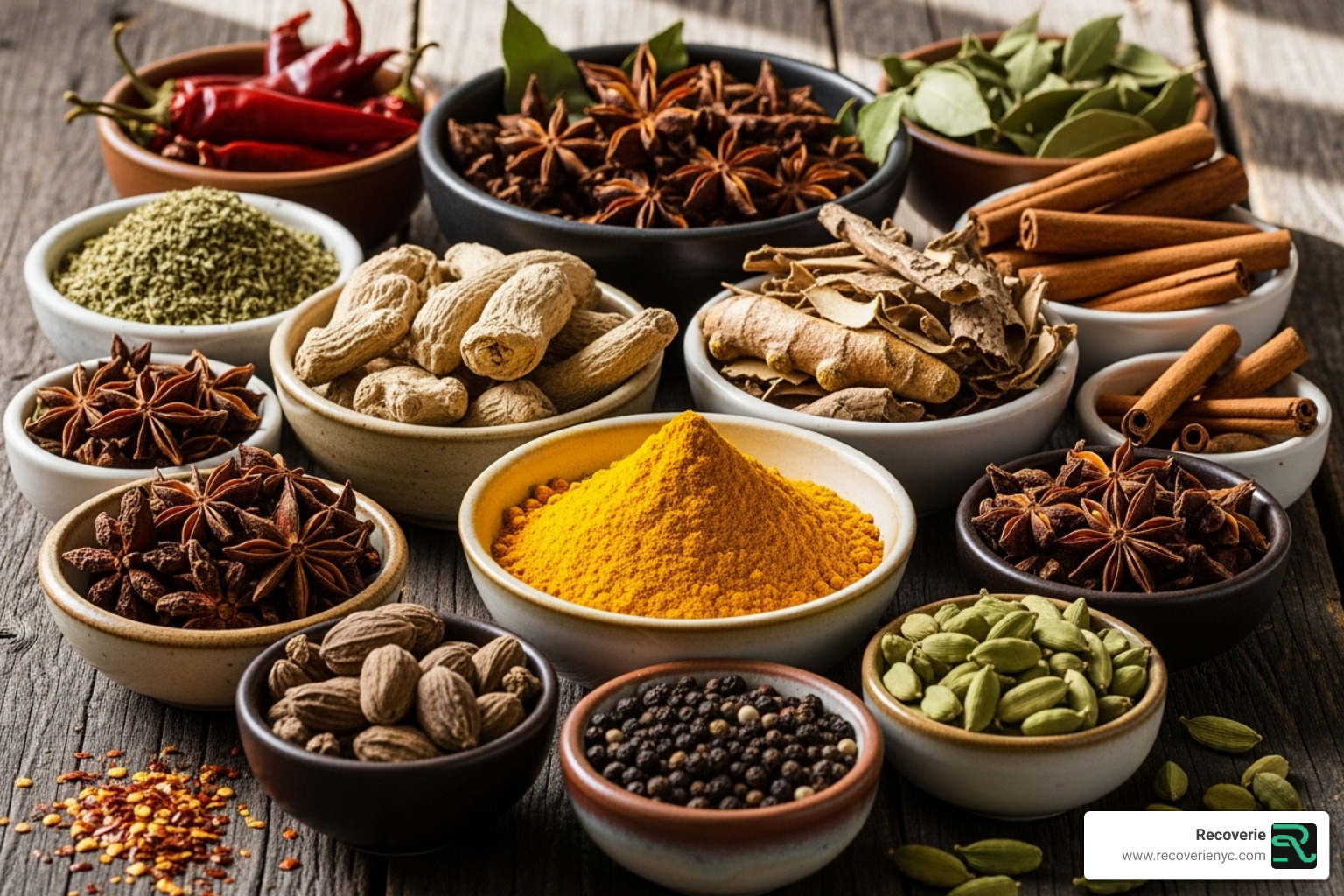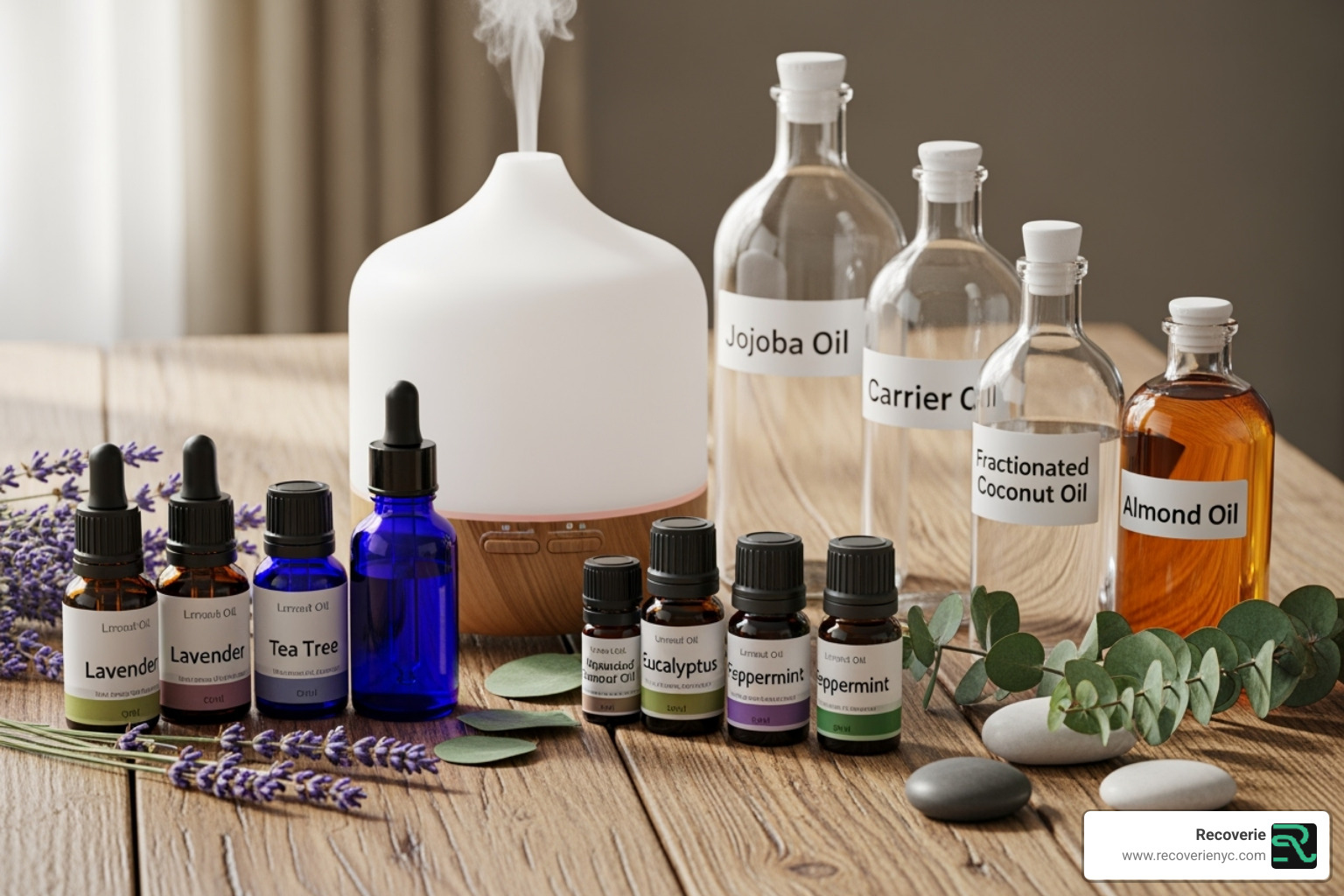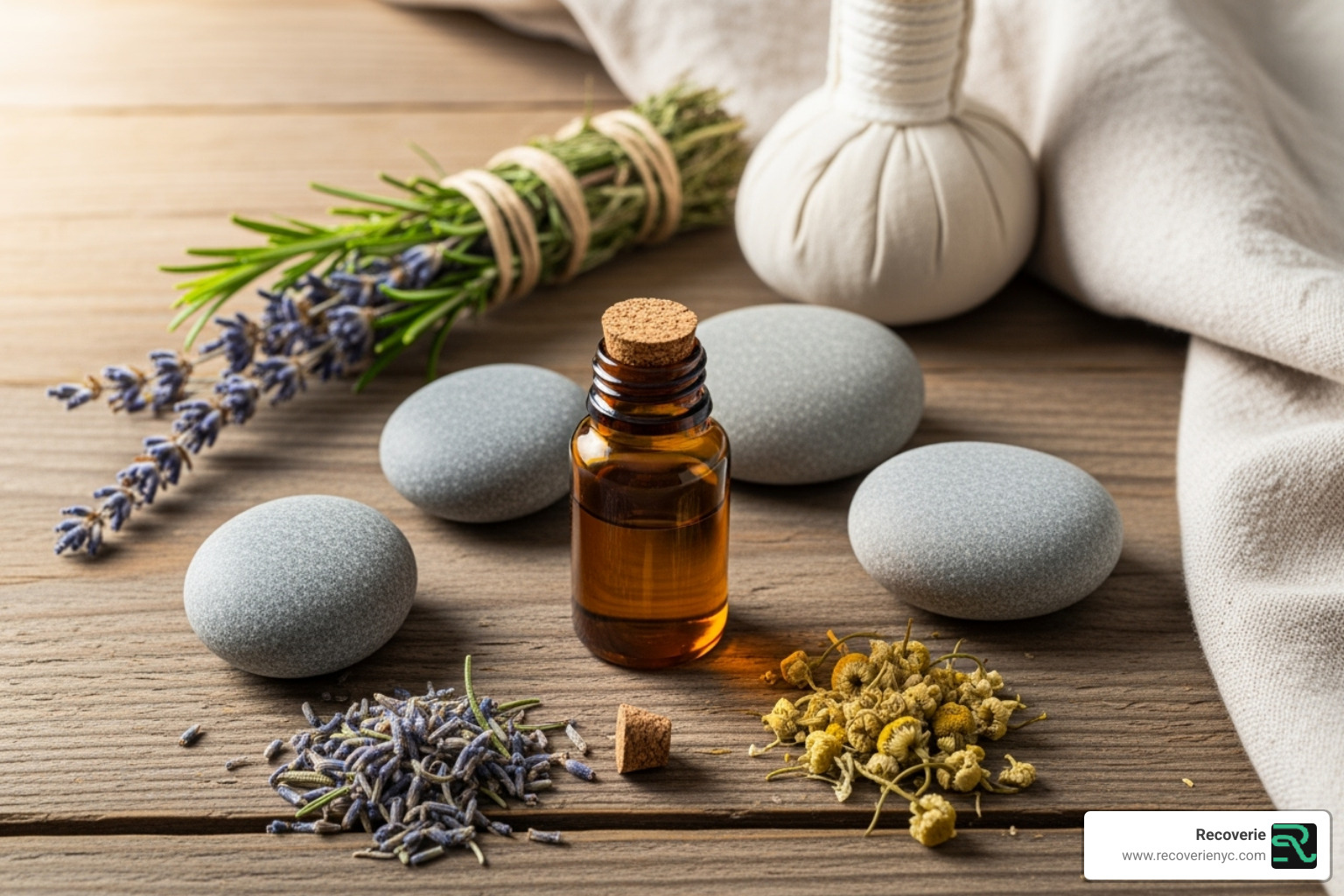Beyond the Pill: Top Natural Ways to Ease Your Pain
Understanding Natural Pain Relief

Natural pain relief offers ways to manage discomfort without relying solely on medication. It often involves using the body's own healing powers and embracing holistic methods.
- Lifestyle adjustments
- Herbal remedies and supplements
- Complementary therapies
In today's world, many urban professionals face daily stress and physical discomfort. For too long, the go-to solution for aches and pains has been a pill. But while traditional pain relievers have their place, they often come with side effects.
This has led to a growing interest in alternative, drug-free approaches. People want more sustainable ways to feel better. They seek methods that support overall well-being, not just mask symptoms. This shift is clear: for example, the number of Americans who meditate has risen more than threefold since 2012, showing a wider accept of natural paths to health.
This guide will explore how you can tap into your body's innate ability to heal. We'll look at simple changes and powerful natural allies to help you find lasting comfort.

Using Your Body's Inner Pharmacy: Lifestyle and Movement
Your body comes equipped with something amazing: its own natural pain relief system. Deep inside your brain, tiny structures are busy creating powerful substances called endorphins . These natural painkillers work just like prescription medications, but without the side effects.
You've probably felt this inner pharmacy at work. Peaceful feeling after a good laugh? Or the calm that washes over you after a gentle walk? That's your body's healing power in action.
The beautiful thing about natural pain relief is that you have more control than you might think. Simple changes in how you move, sleep, and eat can open up your body's ability to heal itself. It's not about taking something new—it's about supporting what's already there.

Move Your Body to Ease Your Pain
Here's something that might surprise you: when you're hurting, gentle movement often helps more than staying still. Your joints need motion to stay healthy, just like a door hinge needs to move to avoid getting rusty.
When you move, several wonderful things happen. Your blood starts flowing better, carrying healing nutrients to sore spots. Your joints get the lubrication they need. Most importantly, your brain releases those natural endorphins that block pain signals.
We're not talking about running a marathon here. Yoga-inspired stretching can work wonders for tight muscles. A simple walk around the block gets your blood moving and your endorphins flowing. Even basic mobility exercises done in your living room can make a real difference.
The key is starting small and being gentle with yourself. If you've been avoiding movement because of pain, begin with just five minutes of gentle stretching. Your body will thank you for it.
The Critical Role of Sleep and Stress Reduction
Pain, stress, and poor sleep create a frustrating cycle. When you hurt, it's hard to sleep. When you don't sleep well, everything hurts more. When you're stressed about the pain, your body releases cortisol , which makes inflammation worse.
The good news? Breaking this cycle is possible with some simple tools.
Meditation has become incredibly popular for good reason. The number of Americans who meditate has risen more than threefold since 2012. When you meditate, you activate your body's relaxation response, which naturally reduces pain signals.
Don't worry if you've never meditated before. Start with just deep breathing . Breathe in slowly for four counts, hold for four, then breathe out for six. This simple practice tells your nervous system it's safe to relax.
Sleep hygiene matters too. Try to go to bed at the same time each night. Keep your room cool and dark. Avoid screens for an hour before bed. These small changes can dramatically improve how your body handles pain.
Eating an Anti-Inflammatory Diet
What you eat directly affects how much pain you feel. Some foods fan the flames of inflammation, while others help put the fire out.
Omega-3 fatty acids are inflammation fighters. You'll find them in salmon, walnuts, and flaxseeds. These healthy fats are so powerful that research shows 59% of patients could substitute fish oil for NSAIDs.
Leafy greens like spinach and kale are packed with antioxidants that calm inflammation. Berries contain natural compounds that reduce swelling. Nuts provide healthy fats and protein that support healing.
On the flip side, processed foods high in sugar and unhealthy fats can make pain worse. They trigger inflammatory responses that your body doesn't need when it's trying to heal.
Don't forget about hydration . Water helps your joints stay lubricated and helps your body flush out inflammatory waste products. Aim for clear or pale yellow urine as a sign you're drinking enough.
The anti-inflammatory approach isn't about strict rules or giving up everything you enjoy. It's about making more choices that support your body's natural healing abilities.
The Power of Plants: Top Herbs and Spices for Natural Pain Relief
Guess what? Your kitchen pantry might just be a hidden treasure trove for natural pain relief ! For centuries, our wise ancestors turned to nature's bounty for healing. And it turns out, they were onto something big. Herbs and spices aren't just for making your meals delicious; many are packed with amazing compounds called phytochemicals. Think of them as tiny warriors with powerful anti-inflammatory and antioxidant superpowers.
They can help calm angry tissues and protect your cells from damage. While scientists are always learning more, a lot of traditional wisdom is now backed by solid research. When you're exploring herbal supplements, remember to always choose quality products. And, it's always a good idea to chat with a healthcare professional, especially if you have any health conditions or are taking other meds.

Turmeric and Curcumin
This bright yellow spice, famous in curries, is a true superstar for natural pain relief . Its main active ingredient is curcumin . This powerful antioxidant does a fantastic job of protecting your cells. It also cools down inflammation by calming pathways in your body that trigger it.
Turmeric has been especially studied for helping with arthritis pain. Some research even suggests it can ease discomfort in a way similar to certain over-the-counter pain relievers. While it's a great ally, think of it as a helpful addition, not a total replacement for other treatments. You can easily add turmeric to your diet in smoothies, juices, or even a soothing "golden milk." If you're looking for more concentrated benefits, standardized supplements are available. Want to dive deeper? You can learn more about the scientific research on Curcuma longa.
Ginger: A Natural Anti-Inflammatory
Often playfully called "the natural ibuprofen," ginger has been a go-to remedy for ages. This zesty root contains special compounds that are amazing at easing all sorts of aches. It's fantastic for muscle soreness , calming nausea , and even helping with migraines . In fact, one study showed ginger powder could be just as effective as ibuprofen for pain after surgery!
A 2015 review found that just two grams of ginger a day could modestly reduce muscle pain from exercise if taken for at least five days. You can enjoy ginger in so many ways: brew a warm cup of ginger tea, toss fresh ginger into your smoothies or stir-fries, or take it as a supplement. Its lovely warming properties also make it wonderfully comforting for general aches and pains.
Capsaicin: The Heat That Heals
Ever felt the fiery kick of a chili pepper? That sensation comes from capsaicin . But here's the cool part: that same heat can actually bring soothing relief! When applied topically, capsaicin works by gently desensitizing your nerve endings. Think of it like turning down the volume on pain signals. This helps support healthy nerve signaling and can effectively reduce how much pain you feel.
A 2020 study even highlighted how capsaicin can offer significant pain relief, and also improve sleep, fatigue, and overall quality of life for those dealing with chronic pain. You'll typically find capsaicin in topical creams and patches. These are often used for nerve pain , joint support , and muscle aches . Just a heads-up: start with a lower concentration and follow the directions carefully, as you might feel a warm, tingling sensation at first!
Other Powerful Herbal Allies
Beyond our star players—turmeric, ginger, and capsaicin—there are several other incredible herbs that offer significant potential for natural pain relief . Here's a quick look at some of our favorites:
| Herb/Spice | Pain Type | Usage | Considerations |
|---|---|---|---|
| Willow Bark | Headaches, back pain, arthritis, fever, cold/flu symptoms | Oral supplements (salicin converted to salicylic acid) | Often called "nature's aspirin"; can have effects similar to Aspirin. Important: Consult your doctor if you're on blood thinners or allergic to aspirin. |
| Boswellia (Frankincense) | Arthritis, inflammatory bowel disease, asthma, general inflammation | Oral supplements (boswellic acids) | This ancient resin helps calm inflammation by inhibiting certain enzymes. It can be quite effective for conditions like osteoarthritis. |
| Feverfew | Migraines, headaches | Oral supplements, tea | Primarily used to help prevent migraines. Be aware it might interact with blood-thinning medications. |
While these herbs are natural, they are still potent and can interact with medications or have side effects. Think of them like powerful tools in your wellness toolbox. It’s always best to chat with a qualified healthcare professional before adding any new supplements to your routine. This is especially true if you have existing health conditions or are taking other medications. And remember, fresh, whole ingredients are often healthier than isolated supplements. So, whenever possible, try to incorporate these wonderful plant allies directly into your diet!
Aromatic Allies: Using Essential Oils to Soothe Aches
There's something magical about the power of scent. Essential oils—those concentrated aromatic treasures extracted from plants—have been nature's pharmacy for centuries. When it comes to natural pain relief , these potent plant essences offer a gentle yet effective approach that works through both our sense of smell and direct skin contact.
Think of essential oils as nature's concentrated healing power, packed into tiny bottles. But here's the thing: these oils are incredibly potent. Always dilute them in a carrier oil like jojoba, sweet almond, or coconut oil before applying to your skin. And please, never swallow them—they can be toxic when ingested.

Lavender Oil for Relaxation and Pain
If essential oils had a popularity contest, lavender would probably win. This purple wonder isn't just about creating a spa-like atmosphere—it's a serious player in the pain relief game. Lavender oil brings together calming effects and genuine anti-inflammatory properties, making it perfect for both physical discomfort and the stress that often comes with it.
What makes lavender special is how it tackles pain from multiple angles. Research suggests lavender oil has pain-relieving effects , showing it can actually decrease pain intensity in various situations. It's particularly helpful for headache relief and works as a natural sleep aid —and better sleep often means less pain the next day.
You can use lavender oil in several ways. Add a few drops to your diffuser for aromatherapy benefits, mix it into a warm bath for full-body relaxation, or dilute it with a carrier oil and gently massage it onto your temples when a headache strikes. The soothing scent alone can help melt away the stress and anxiety that often make pain feel worse.
Peppermint Oil for Headaches and Muscle Spasms
Peppermint oil is like nature's cooling gel. Thanks to its high menthol content, it creates that refreshing cooling sensation that can literally distract your nerves from pain signals. It's particularly brilliant for tension headaches —those tight, squeezing headaches that feel like your head is in a vice.
A 2015 review on peppermint oil highlighted its impressive potential for muscle comfort and easing spasms. When you apply diluted peppermint oil to tight, knotted muscles, that cooling effect helps relax the tension and provides genuine relief.
For headaches, try diluting a drop or two in a carrier oil and gently massaging it onto your temples and forehead. You can also inhale peppermint oil vapors for a decongestant effect that helps with sinus-related headaches. Just remember to keep it away from broken or irritated skin—that cooling sensation can become quite intense on damaged tissue.
Eucalyptus Oil for Sinus and Joint Pain
Eucalyptus oil is like a breath of fresh mountain air captured in a bottle. While most people know it for clearing stuffy noses, this Australian native also packs impressive anti-inflammatory properties that can bring relief to achy joints and sore muscles.
What's fascinating is how versatile eucalyptus can be. For congestion relief , you can add a few drops to a bowl of hot water and breathe in the steam—it's like having your own personal spa treatment. For joint comfort , dilute it in a carrier oil and massage it into problem areas.
But here's an important safety note: eucalyptus oil has potential for decreased respiration in children , so keep it away from little ones. Always dilute it properly and use it sparingly—a little goes a long way.
The beauty of essential oils is that they offer a gentle, natural approach to pain management that engages multiple senses. Whether you're dealing with everyday aches or looking for ways to improve your overall wellness routine, these aromatic allies can be valuable additions to your natural pain relief toolkit.
Hands-On Healing: Complementary Therapies for Natural Pain Relief
Sometimes the best natural pain relief comes from the healing power of touch and guided movement. When we think beyond what we put in our bodies, we find a whole world of hands-on therapies that can transform how we feel. These approaches don't just mask pain – they work with your body to address the underlying causes while building a supportive community around your healing journey.
Bodywork and Massage Therapy Approaches
Your muscles hold onto stress and tension like a filing cabinet holds old papers – sometimes you need someone else to help you sort through it all. Massage therapy is one of the most effective ways to open up your body's natural healing abilities. Even just 10 minutes of massage can trigger your muscles to release inflammation-reducing signals.
The magic happens through improved circulation and the release of those wonderful endorphins we talked about earlier. When skilled hands work on tight muscles, blood flow increases, bringing fresh oxygen and nutrients while carrying away waste products that contribute to soreness.
Myofascial release takes this a step further by focusing on the connective tissue that wraps around your muscles like plastic wrap around leftovers. When this tissue gets tight or stuck, it can create pain that seems to come from nowhere. By gently working on these areas, therapists can help restore mobility and reduce pain significantly.
Studies show that deep tissue massage can be just as effective as over-the-counter pain medications for chronic low-back pain. The best part? No side effects, just the blissful feeling of tension melting away.
Guided Movement and Recovery Modalities
Movement truly is medicine, but sometimes we need a guide to show us the way. Assisted stretching with trained professionals can safely take your flexibility further than you might manage alone. It's like having a personal trainer for your tight spots, helping you move better without the risk of pushing too hard.
Recovery-focused movement practices like gentle yoga or Tai Chi combine the benefits of exercise with mindfulness. These ancient practices have stood the test of time because they work – building strength and stability while calming the nervous system.
At Recoverie, we've taken recovery to the next level with cutting-edge natural therapies. Our Brooklyn location on the waterfront offers cryotherapy , where brief exposure to extreme cold rapidly reduces inflammation and pain. Think of it as nature's reset button for your entire system.
Ice baths provide similar benefits in a more gradual way, promoting muscle recovery and reducing soreness. Many of our members find the mental clarity that comes with cold therapy just as valuable as the physical benefits.
Our red light therapy uses specific wavelengths of light to stimulate your cells' natural healing processes. It's like giving your body's repair crew the perfect tools to reduce inflammation and speed recovery. You can learn more about our advanced recovery services and how they fit into your wellness journey.
What sets these approaches apart is the community aspect. Healing happens faster when you're surrounded by others on similar journeys, sharing experiences and supporting each other's progress.
Safety First: When to See a Doctor
While natural pain relief offers incredible benefits and can significantly improve our quality of life, it's super important to approach it with a clear understanding of its limits. "Natural" doesn't automatically mean "risk-free." Think of it like this: sunshine is natural and wonderful, but too much can still give you a sunburn! We always advocate for a balanced approach that puts your safety and well-being first.
Understanding Risks and Interactions
When we choose natural remedies, especially supplements, it's good to remember that they aren't regulated by the FDA in the same strict way prescription drugs are. This means what's on the label might not always match what's in the bottle, or there could be unexpected ingredients. Sometimes, "natural" supplements have even been linked to serious side effects.
More importantly, natural herbs and supplements can sometimes mix poorly with medications you might already be taking. This could make your medication less effective, or even cause harmful side effects. For instance, certain herbs like willow bark , Boswellia , or even common cloves can interact with blood-thinning medicines, increasing your risk of bleeding. So, always be open and honest with your doctor and pharmacist about all the remedies you're considering, natural or otherwise. They're your best resource for staying safe!
When is Natural Pain Relief a Good Choice?
So, when can natural pain relief truly shine? It’s often an excellent choice for a variety of common discomforts:
For chronic inflammatory pain , like what you might feel with arthritis or fibromyalgia, natural approaches can be incredibly helpful. Think anti-inflammatory diets, specific herbs like turmeric, and consistent, gentle movement. These strategies can work wonders to calm things down in your body.
If you're dealing with everyday muscle soreness from a tough workout, tension headaches, or just general aches and pains, natural methods are often a fantastic first line of defense. Things like heat or cold therapy, a good massage, soothing essential oils, and gentle movement can provide a lot of comfort.
Even for mild to moderate headaches , many people find relief with natural options. Peppermint oil, ginger, and simple relaxation techniques can be surprisingly effective. For those with fibromyalgia, a holistic approach that includes diet, exercise, stress reduction, and complementary therapies can truly improve daily symptoms and overall well-being. For these types of pain, natural methods can be very effective, often with fewer unwanted side effects than traditional medications.
When to Seek Professional Medical Advice
While we absolutely encourage you to explore natural options and empower yourself, there are definitely times when professional medical attention is a must. Pain is your body's way of sending you a signal, and sometimes that signal needs an expert to interpret it. Don't hesitate to reach out to a doctor if you experience:
- Sudden, severe pain , especially if it comes out of nowhere.
- Pain that starts right after an injury – it's important to rule out anything serious like a fracture.
- Numbness or weakness , particularly if it goes along with back or neck pain, as this could mean nerve trouble.
- Unexplained weight loss or a persistent fever accompanying your pain, as these can be signs of underlying medical conditions.
- Pain that consistently disrupts your daily life , making it hard to work, sleep, or enjoy your favorite activities.
- If your pain simply doesn't improve after a reasonable time, even after trying natural remedies or over-the-counter options.
Your doctor can help figure out what’s truly causing your pain and guide you to the best course of action. This often includes a smart combination of conventional and natural treatments. Professionals specializing in integrative medicine can be particularly helpful, as they have training in both worlds. For valuable self-management tools and resources, you might also find guidance from places like The Pain Toolkit. Your health journey is a team effort, and your doctor is a key player!
Conclusion
Embracing natural pain relief is truly about adopting a holistic approach to your health. It’s about understanding that our bodies are incredible, interconnected systems, and that genuine well-being comes from nourishing every part of ourselves – physical, mental, and emotional. Throughout this guide, we've explored how simple lifestyle changes, the potent power of plants, the soothing touch of essential oils, and the benefits of hands-on complementary therapies can significantly ease your pain and beautifully improve your quality of life.
This journey is all about empowerment. It's about taking an active, joyful role in your own health and well-being. It means combining strategies that truly resonate with you, helping you build a personalized care plan that supports your body's incredible natural healing abilities. And here’s the wonderful part: you absolutely don't have to steer this path alone.
Here at Recoverie, we truly believe in empowering you with the right tools and a supportive community to help you reset and thrive. Nestled by Brooklyn Bridge Park, we're dedicated to offering advanced, natural therapies and personalized care in an environment where New Yorkers can truly recover, reset, and thrive. We are here, ready to guide you on your journey to lasting comfort and vitality.
Ready to take the first step towards feeling better, naturally? Explore our natural therapies to start your recovery journey.










